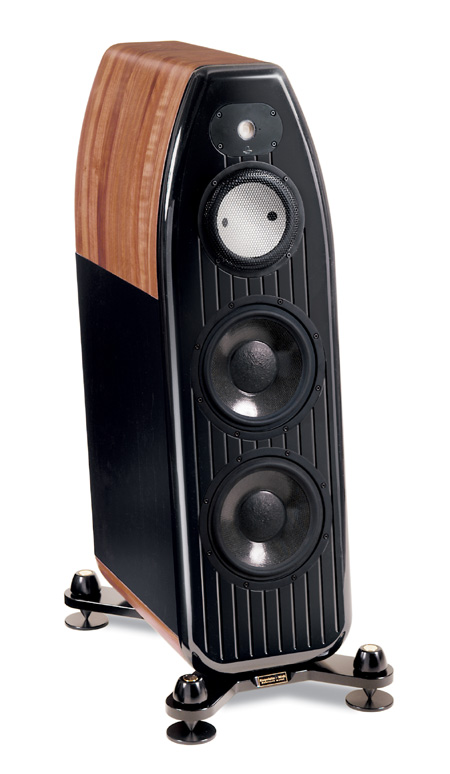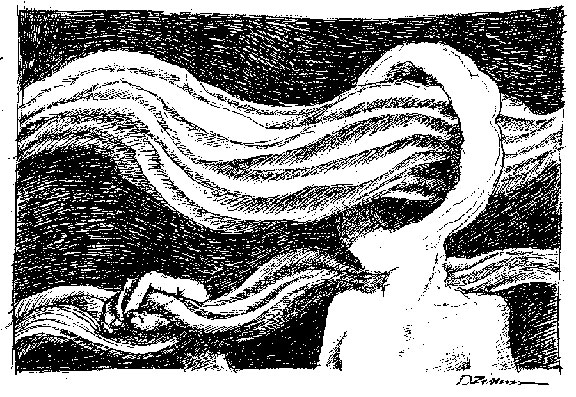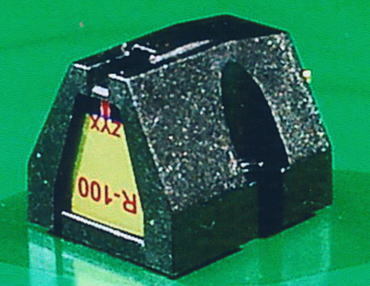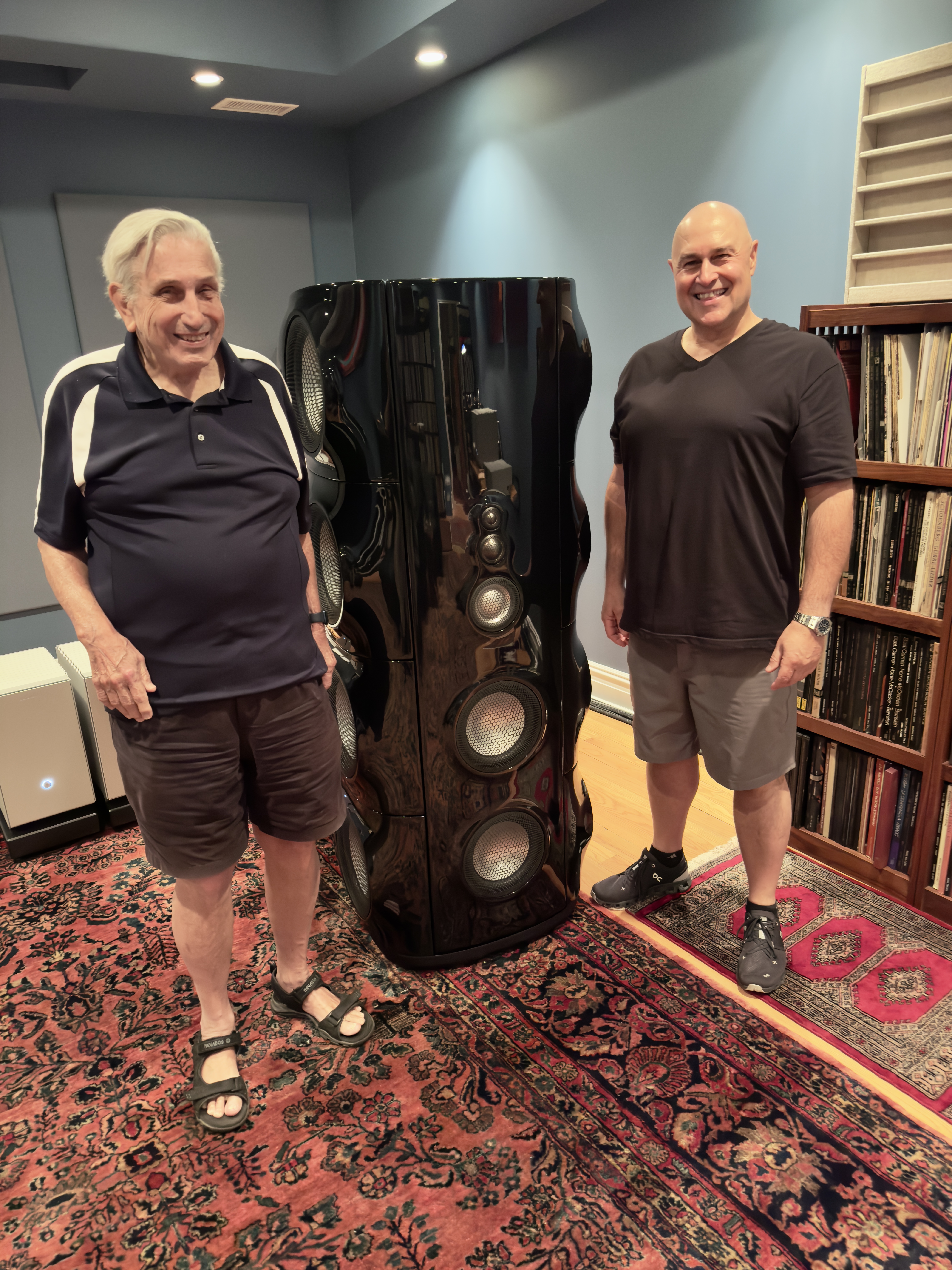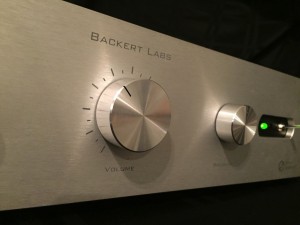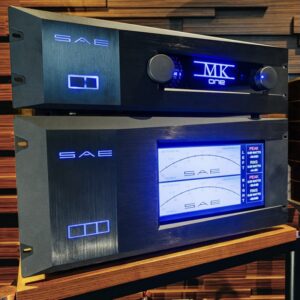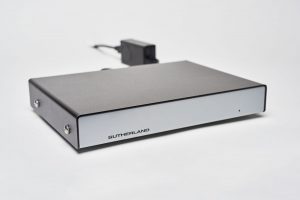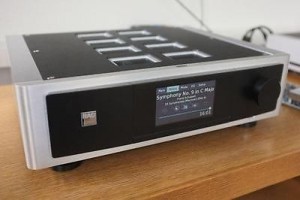This article, by Carol Clark, Victor Chavira, Larry Cox, and Larry Fisher, originally ran when audioMusings was in print - Issue 9, 1999.
When was the last time music inspired you to dance? No, I don't mean the obligatory dancing you do at say, a wedding—I'm talking about the pure, unadulterated dancing that you do for pure pleasure. The times when you spontaneously leap up out of your seat and just dance. Can't remember? Well, for me, it was while listening to the Sim Celeste P-5003 preamplifier. In the course of reviewing the P-5003, I put on one of my favorite recordings, Sky Cries Mary's This Timeless Turning. As I stood up to change the CD during "Every Iceberg Is Afire," I was struck by the urge to dance. I don't have rhythm, but something about the way the music sounded just communicated itself to my feet, and dance I felt I must.
Before I get to the P-5003, I must report that Dave's and my Reference system has changed, somewhat against my will. I've had a good, long relationship with our Apogee Calipers, but another member of my family longed to bid them goodbye, so bid them goodbye we must. I'm still in the "getting used to them" stage with our new speakers, the Reimer Wind Rivers. I'm sure I'll eventually be as enamored of them as I still am of the Apogees, but I tried not to let the fact that this hasn't happened yet color the reviewing process.
From what I can decipher from the manual that came with the P-5003, Sim has used some innovative technology inside this unit that derives from their top-of-the-line products. I'm not well versed on the technology, but here's what I do know: This preamp does not sound like solid state. I found myself being totally transported by the music while this preamp was in our system. Listening to Mezzanine by Massive Attack, I heard a full soundstage that extended far behind, and well out into the room in front of the speakers. Staging from side to side was impressive as well. Details were especially noticeable during the song "Risingson," in which vocalist 3D intones in an almost trance-like voice. I listened to Toward The Within by Dead Can Dance, and my favorite track "Don't Fade Away" sounded better than ever. Vocals were smooth, the guitar sounded live. Sky Cries Mary I've already mentioned, but tracks on that disc that have sounded brittle in the past (most notably "These Old Bones") sounded rich and not brittle at all.
I feel I must mention the remote control. When I last reviewed a Sim product, I mentioned the excessive weight of the remote. At CES this year, I had a talk with Lionel Goodfield of Sim about it. He assures me that the remotes are heavy to withstand the beatings they are usually subjected to. Okay, I accept that. I meant to weigh it this time, though, to report to you that it really is heavy, and that it is not my imagination. Alas, I forgot. On a positive note, though, I have to say that Sim has made this remote quite special indeed. It is compatible with RC-5 communication protocols, which means it can be used with Phillips-based CD players, AC3 decoders, and digital tuners. It is not compatible with my EAD, so I couldn't test it, but if it can minimize the number of remotes you have, that's certainly positive.
I resoundingly recommend the Sim Celeste P-5003. It's a solid state unit that sounds levels above other solid state units in its range. It compares quite favorably to my current preamp, the Blue Circle BC-3, but costs quite a bit less. I'm not yet ready to replace the Blue Circle, but those looking to trade up from a budget preamp are encouraged to give the Sim P-5003 a try. Carol Clark
Until recently, I have been the attic man. When speakers got shipped to audioMUSINGS, they went to Larry. Amps, those went to Larry, too. Everything came to me—kind of a blessing and kind of an annoyance, as you can imagine. When the stuff arrived, I'd check it out to see if the tweeters, binding posts, etc. were still attached, then called the manufacturers to let them know that all appeared okay. When time and interest permitted, I'd try out some stuff, supposedly to make sure it worked, but actually because I just wanted to try it. That's what happened with the Sim Moon P3 preamp.
I LOVE the sound of my E.A.R. 802 preamp. It is amazing—the sound is liquid and detailed, with a great tonal balance filled with all of the colors of music. With the proper matching products, the 802 demonstrates exceptional frequency extension. It is, however, of the hair shirt school of convenience. Change the volume? Get up off your butt. Change the source? Get up off your butt. Turn it off? Get up off your butt. Enter the Moon P-3. Remote everything, from volume level to source selection to balance control, and you can turn it off without getting off your butt. You can skip from one source to another without having to scroll through every source between the one you were listening to, to listen to the one you choose. And, the remote control must be seen and used to be appreciated. It is built strongly enough to beat burglars into submission, and will probably last into the next millennium. One small beef I had was that the remote was supposed to work with Phillips-based products, and while my CAL Icon is Phillips-based, the remote didn't access it. A small qualm, but there you have it.
So, you ask, what about liquidity, what about tonal balance, what about the colors of music and frequency response? Well, beginning at the end, the Moon P-3 has excellent bass extension. My current amplifier, the Musical Design DM100B, doesn't grab the bottom end of my speakers as well as more potent amps do, at least when combined with the E.A.R. With the Moon, a bit more bottom end extension was present and enjoyed. Bass was fast, tight, and deep, albeit not quite as rich-sounding as with my reference preamp. So for me, this is an apples-vs.-oranges comparison—you decide for yourself between a little more extension and a little more color. The Sim's midrange is quite transparent, revealing easily what instrument is being played. Female vocals were clear, though a bit drier and not as full bodied as they are with my reference (tube) preamp. The vocals were also ever so slightly more "one-note-ish" than with my E.A.R. Additionally, images were more palpable with my reference. The Moon was still more than just nice. Absent a really exceptional performer like the E.A.R., the Moon would be an easy choice for its midrange. The top end was a bit more open and extended than the E.A.R.'s, which was welcome, though with a small cost attached. The extension also brought an ever-so-slightly etched quality, as though cymbals were a bit heavier and had a more "on-off" quality than the rolling, continuous sound of the E.A.R. and live music.
I haven't heard the Sim Celeste line of products, but I have heard two of the Sim Moon products and I'm impressed. The quality of the sound in my system would satisfy the most discriminating listener, easily and happily. I'm an unapologetic tube-aholic, and so have a preference for the sound of my tube preamp, but my E.A.R. is nearly double the price of the P-3. That makes the Sim an excellent value, and, to clinch the deal, you get remote capability. Larry Cox
The SimAudio is the fourth preamp that I have had the pleasure to evaluate thus far. While in each case I've enjoyed the greater flexibility and control that a preamp provides, the variable output of my Audio Electronics CD1 continues to serve as the sole controller in my system. Last year I evaluated and purchased a Harmonic Recovery System, which improved the interface between the CD1 and my Anthem Amp1. However, the HRS was not used during the course of this evaluation.
The SimAudio preamp is very well built. It shares features with the Sim Moon I-5 integrated amplifier that I reviewed positively a few issues back. The most notable similarity is the RBG volume control, which is neither a stepped attenuator nor an analog potentiometer. Instead, volume control is achieved though a series of microprocessor-controlled shunts. Source selection and balance are also microprocessor-controlled, and isolated from the analog section. The preamp was placed atop the large CD1 and plugged directly into the wall. I found the heavy-duty remote to be most useful as it also controlled my CD player. Immediately upon installing the preamp, the sound of my system perked up. I now had a greater range of volume control at my disposal, which had a positive effect on dynamics. Gradations and the intensity of sounds became more apparent.
The preamp is also similar in sound to the Moon I-5, smooth and grain-free. Hard and etched are not words I would use to describe any product from the house of Sim. The sound was essentially neutral, with a hint of sweetness in the upper registers. The Sim's delicate way with strings and woodwinds complemented the sound of my Anthem Amp1. Some preamps can add a very fine veil to the music, but the Sim committed no such sin, nor did it add a feeling of sameness to the music. Each recording retained its particular production values.
The Sim also complemented my system with its fabulous rhythm and drive. Latin Jazz and flamenco were well served by its speed and transparency. Clicks on a clave were upbeat and lively. In the end, I enjoyed the Sim preamp for its sound design and versatility. This component would make a solid centerpiece in a very musical system. Victor Chavira
I've always felt that specific components in my system are responsible for limiting its quality of sound. At the top of the list is the Adcom tuner/preamp I use as a tuner and phono stage. Next is my Sumiko Blue Point cartridge, followed by the Cal Audio CD player. In looking over old issues of The Earful, an audio newsletter I used to help out with, I noticed that even five years ago I felt my CD player was "in desperate need of an update." At the bottom of the list was my Melos SHA 1 preamp. Oh, how my perspective on this was about to change!
The SimAudio Celeste P-5003 remote-controlled preamp is a good-looking unit, with a thick front plate and a chassis that is curved on the sides. The curvature is provided by the heat sinks, which never got warm during normal play or the burn-in process. The ergonomics of the preamp are pretty good—the switches have a good tactile response and the volume control has a solid feel. Operation is straightforward. There is a main power switch in the back and a standby switch on the front. Volume levels for both channels are displayed in very bright, large, red LEDs, easily viewed from across a room. The LEDs can be turned off, but will temporarily display any setting that is being changed. Balance is altered by setting one channel higher or lower than the other. (I remember not buying a preamp once, partly because I figured I'd spend more time tweaking its dual volume controls than listening to music. This won't happen with the Celeste because of the feedback you get from the display.) I used the balance function on the remote control several times over the course of the review, mostly while sitting in a chair that wasn't in the sweet spot. I was not able to obtain the same sound perspective in these outlying positions that I got while sitting in the middle, but there was enough of an improvement to make me consider getting a preamp with balance adjustment when I replace the Melos. The only complaint I have about the preamp's operation is how the inputs are selected. There are seven line-level inputs and one for home theater use. Unless I missed something in the manual and during use, the inputs are selected serially, so that if you are on CD (input 1) and you go to your tuner (input 2) to check the news or the score of a game, then want to go back to the music, you have to cycle through all the other inputs to get back to the first one. A mechanism for reversing direction would have helped.
I was the first audioMUSER to review the Celeste, so I got the honor of performing a full burn-in. SimAudio recommends a minimum of 100 hours and suggests at least 250. To accomplish this, I connected a portable CD player to the Celeste and used the burn-in track on a test CD I own. The preamp, with its volume control set to maximum, was connected to a powered-off amp.
The burn-in track was repeated off and on over the entire time I had the preamp, for a total of well over 240 hours. Serious listening began at around 220 hours and, as I do for any review, I cleaned all terminals and connectors using TPC (The Perfect Connection), a product put out by XLO. Before I began the burn-in process, I installed the preamp in my system to get an initial taste of its sound. On first listen, the Celeste reminded me of an Audio Alchemy preamp I had in my system several years ago. The sound was precise, but everything was accentuated. However, I didn't keep the preamp in my system very long.
One of the problems I thought I was going to run into while reviewing the Celeste preamp was matching its output to that of my Melos preamp, so that comparisons between the two would be fair and accurate. For volume control, the Melos has a potentiometer with a limited number of detents. The Celeste has 50 distinct settings on its volume control. These are not the typical logarithmic or linear settings, but were chosen by the Sim design team, so I figured matching the two preamps would be next to impossible. To determine playback level, I played a constant output track from a test CD, set up a voltmeter across a pair of speaker terminals, and measured the voltage of ten settings on each preamp. To my surprise, two settings on the Melos preamp that were around my normal settings were within 0.001 volts of settings on the Celeste. What luck. Actually, after rereading the owner's manual, it turns out that the first 20 settings of the Celeste's volume control are for extreme precision at low levels, so it wasn't luck, just someone designing a useful feature into a product.
Once I inserted the Celeste preamp into my system, I didn't want to review it, because doing so meant I'd have to remove it and reinstall my old preamp for comparison. Life just isn't fair. The Celeste preamp allowed my system to present a fare amount of evenly-placed detail without fatigue, gobs of dynamics without losing the musical flow, a 3D soundstage that extended to the corners of the room without misplacing any sound source, and a punchy bass line without the addition of a subwoofer. The end result being equal to a system upgrade that I thought would take several components to achieve. Over the course of the review, I could not find any musical source that did not benefit from having the Celeste in my system. I continue to use a wide range of music when reviewing equipment. I chose the following for this review: Eva Cassidy, "Fields of Gold," from Songbird (Blix Street Records); Leopold Hoffman, Cello Concerto in D major, with Tim Hugh and Northern Sinfonia (Naxos); Stevie Ray Vaughn and Double Trouble, "Voodoo Chile (Slight Return)," from Couldn't Stand the Weather (Epic).
On the first track of the Eva Cassidy CD, the Celeste presented a smooth, stable singer, with precise images hanging in the air. The soundstage filled the corners of the room with sound you'd expect in a live recording. Reverb and tape hiss were more noticeable, but hearing notes trailing off into a blackness not experienced in my reference system made that seem trivial. In comparison, the Melos preamp presented the singer as more spitty and nasal. Tape hiss was not as noticeable, but there was a smaller, flatter soundstage. The Melos presented the Hoffman concerto in a pleasing, light and airy fashion. However, the soundstage appeared closed in and did not even fill the gap between the speakers. There was depth, though instruments appeared stacked behind the cello, which sounded a bit like a big violin. With the Celeste in the system, the cello had more weight, and also appeared to be raised in height, as if it were closer to the stage. The soundstage opened up to the fullest extent possible. The drums in the opening moments of track four of the Stevie Ray Vaughn CD had a nice attack with the Melos, but the Celeste was able to control the sound better, giving it a punchy quality I could feel in my chest. The Celeste also removed a layer of gauze from the sound that was present when using the Melos. All in all, the Celeste made it easy to follow just about any instrument on this and every other recording.
Listening to this preamp has made me rethink my system. At a minimum, I'm going to search out a better tube for my preamp. I doubt I will be able to meet or beat the Celeste, but now that I have a reference to shoot for, I should be able to move in the right direction. I did not know the cost of the Celeste when I was reviewing it—only after I completed the review did I find out that it costs more than several major pieces of my system combined. Even knowing this, I find myself thinking about it and smiling whenever I turn my system on. Larry Fisher
SimAudio P-5003 Preamplifier
Retail: $1749
SimAudio





